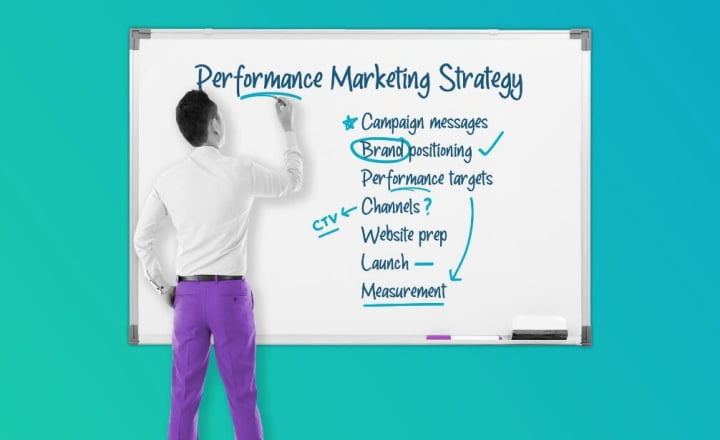In today’s digital landscape, performance marketing has emerged as a powerful strategy for businesses looking to drive results and optimize their return on investment (ROI).
This comprehensive guide will delve into the world of performance marketing, exploring its definition, benefits, various types, measurement metrics, and tips for successful implementation.

By the end of this guide, you’ll have a thorough understanding of performance marketing and how it can help your business grow.
What is Performance Marketing?
Performance marketing is a digital marketing approach in which advertisers pay marketing partners, such as publishers or agencies, only when specific actions are achieved, such as clicks, conversions, or sales.
This performance-driven strategy emphasizes measurable results and ensures that marketers only pay for successful outcomes, making it a cost-effective and ROI-focused approach.
This form of digital marketing spans various channels, including affiliate marketing, native advertising, sponsored content, social media marketing, and search engine marketing.
Performance marketing offers numerous benefits, including increased brand awareness, trackable performance, and minimized risk due to its results-oriented nature.
Types of Performance Marketing
Performance marketing encompasses various marketing strategies, each with its unique benefits and approaches:
- Affiliate Marketing – Affiliate marketing involves partnerships between merchants and affiliates, who promote the merchants’ products or services in exchange for commissions based on successful outcomes.
- Native Advertising – Native advertising involves placing ads that seamlessly blend with the content and design of the websites they appear on, offering a more natural and engaging user experience.
- Sponsored Content – Sponsored content is a form of native advertising that involves publishing branded content on websites or platforms with similar content themes, allowing the sponsored content to integrate smoothly with the surrounding content.
- Social Media Marketing – Social media marketing leverages social media platforms to drive brand awareness, engagement, and conversions, using targeted ad formats and audience segmentation.
- Paid Search Marketing – Paid search marketing involves placing sponsored ads on search engine results pages (SERPs) to capture user attention during keyword searches, driving targeted traffic and conversions.
The Benefits of Performance Marketing
As the digital marketing sector continues to expand rapidly, performance marketing presents a significant opportunity to enhance your business operations by utilizing its complete range of features.
Performance marketing has three major benefits for your business:
- Brand awareness: You can expand your reach and attract more visitors to your website by partnering with affiliates and agencies that have loyal followers. This can help you tap into new audiences and boost your traffic significantly.
- Trackable performance: Performance marketing is a highly accountable and transparent form of marketing. With the help of advanced tracking tools, brands can now easily monitor the entire customer journey from click to purchase. This enables them to make informed decisions regarding where to allocate their marketing budget, which partners to work with, and which channels to focus on for better results.
- Lower risk: Affiliates who are paid after desired actions can achieve a lower CPA (Cost Per Acquisition) and higher ROI. This leaves more room for you to test and expand other performance marketing strategies to grow and compete.
The Core Components of Performance Marketing
Performance marketing relies on four essential groups: merchants or retailers, affiliates or publishers, affiliate networks and third-party tracking platforms, and affiliate managers or Outsourced Program Management (OPM). Each group plays a vital role in driving the desired results:
Merchants or Retailers
Merchants, also known as advertisers, are businesses that seek to promote their products or services through affiliate partners or publishers.
They collaborate with affiliates to define campaign goals and make payments once these goals are met.
Affiliates or Publishers
Affiliates, or publishers, are marketing partners that utilize their platforms (e.g., websites, blogs, social media) to promote merchants’ products or services.
They earn commissions based on the successful completion of desired actions, such as clicks, sales, or leads.
Affiliate Networks and Third-Party Tracking Platforms
Affiliate networks and third-party tracking platforms provide the necessary tools and resources, such as banners, links, product feeds, and promotions, for managing and monitoring performance marketing campaigns.
They also handle commission payouts and offer in-depth reporting on campaign performance.
Affiliate Managers or OPMs
Affiliate managers or OPMs serve as the primary liaison between merchants and affiliates.
They oversee the entire program, ensuring smooth communication, compliance with guidelines, and ongoing optimization for maximum results.
How Performance Marketing Works
Advertisers and their partners employ various payment models in performance marketing, based on the desired outcomes:
- Cost Per Click (CPC) – Advertisers pay for each click on their ads, driving traffic to their websites.
- Cost Per Impression (CPM) – Advertisers pay for every thousand views (impressions) of their ads.
- Cost Per Sale (CPS) – Advertisers pay when a sale or other specified action (e.g., form completion) is completed by a user.
- Cost Per Lead (CPL) – Advertisers pay for each lead generated, such as a form registration or email sign-up.
- Cost Per Action (CPA) – Advertisers pay for each user action, such as sales, form completions, clicks, or other activities.
Top Performance Marketing Channels
Several channels are particularly effective for performance marketing:
Banner (Display) Ads
Display ads appear on websites, social media platforms, or mobile apps, promoting products or services through eye-catching visuals.
It is still possible to drive results with display ads despite ad blockers and “banner blindness.”
Native Advertising
Native ads blend seamlessly with the content and design of the websites they appear on, offering a non-disruptive advertising experience.
They are often more effective than traditional display ads, as they don’t look like ads and provide a more natural user experience.
Content Marketing
Content marketing involves providing valuable information to users, and positioning the brand as an expert in its niche. By creating engaging and informative content, businesses can drive traffic, generate leads, and build customer loyalty.
Social Media Marketing

Target audiences are reached and engaged through social media marketing platforms like Facebook, Instagram, and Twitter. Advertisers can use various ad formats and targeting options to maximize their campaign performance and ROI.
Search Engine Marketing (SEM)
When users search for relevant keywords, search engine marketing involves placing paid ads on search engine results pages (SERPs). This targeted approach can effectively drive traffic and conversions.
Measuring Performance Marketing Success
Performance marketing emphasizes ROI, with every action tracked and measured against predefined key performance indicators (KPIs). Common metrics used in performance marketing include:
- Cost Per Mille (CPM) – CPM measures the cost per thousand impressions, indicating the price paid for every thousand times an ad is displayed.
- Cost Per Click (CPC) – CPC denotes the cost paid for each click on an ad, reflecting user engagement with the advertisement.
- Cost Per Action (CPA) – CPA measures campaign performance based on a specific desired action, such as a sale, download, or subscription.
- Lifetime Value (LTV) – LTV estimates the expected spending of acquired customers over their entire relationship with the brand or company, using predictive analytics to inform marketing strategies and optimize ROI.
Steps to a Successful Performance Marketing Strategy
With these few simple steps, you can create an excellent marketing strategy. Next, explore with Dolma!

Step 1: Establish Your Campaign Objectives
The first step in developing a performance marketing strategy is to determine your campaign goals. These objectives will guide your campaign messaging and help you identify the key performance indicators (KPIs) that you will track throughout the campaign.
Common campaign goals include building brand awareness, increasing product sales, or growing your subscriber base.
It is crucial to have a well-defined campaign objective to ensure that your marketing activities are in line with your overall business objectives. It also enables you to create compelling calls to action that resonate with your audience and inspire them to take the desired action.
Step 2: Define Your Brand Positioning
Once you’ve identified your campaign goals, the next step is to determine your brand positioning. This involves deciding how you want your audience to perceive your brand and what sets you apart from your competitors.
Consider factors such as your unique selling proposition, customer service capabilities, or how your products address specific customer pain points.
Brand positioning plays a critical role in your performance marketing strategy, as it influences your messaging and helps differentiate your brand from the competition. Furthermore, it assists you in selecting the right target audience for your campaign, ensuring that your marketing efforts are focused on those most likely to be interested in your products or services.
Step 3: Set Performance Targets
Performance targets are the measurable benchmarks you’ll use to gauge the success of your marketing campaign.
Based on your campaign goals, determine which digital marketing KPIs you’ll track and set specific targets for each.
This may include metrics such as click-through rates, conversion rates, or revenue generated.
If you’ve run performance marketing campaigns in the past, use historical data to inform your performance targets.
Establishing performance targets allows you to measure the effectiveness of your marketing strategy and provides a basis for continuous improvement. By setting clear benchmarks, you can assess your campaign’s success and refine future marketing efforts accordingly.
Step 4: Choose Your Marketing Channels
A multichannel approach is essential for a successful performance marketing strategy, as it enables you to reach your target audience across various platforms.
After defining your target audience, research which marketing channels are most effective for reaching them and allocate your budget accordingly.
By diversifying your channel mix, you can increase your chances of reaching more members of your target audience and achieving your campaign objectives.
Step 5: Optimize Your Website
You must prepare your website to handle an influx of visitors following a successful performance marketing campaign.

Integrate your website with the call to action in your ads and create dedicated landing pages for your campaign offers. Additionally, ensure that your website is user-friendly, fast-loading, and optimized for conversions.
Research suggests that 76% of customers judge a company by its website, so it’s vital to provide a seamless user experience that encourages visitors to engage with your brand.
Step 6: Develop and Launch Your Campaign
With your performance marketing strategy in place, it’s time to create and launch your campaign. Develop engaging content tailored to each marketing channel, including copy, graphics, videos, and other creative assets.
Consider the unique requirements of each channel to ensure a smooth and effective campaign launch.
The content of your performance marketing campaign is ultimately what will inspire your audience to take action. By tailoring your creative assets to each marketing channel, you can maximize the impact of your campaign and start tracking results as soon as your ads go live.
Step 7: Monitor, Measure, and Optimize
After launching your campaign, it’s essential to continuously track your key metrics and assess the performance of your ads.
If you notice any underperforming elements in your campaign, consider revising your messaging or adjusting your targeting parameters.
Optimize future marketing efforts by conducting A/B testing on your ads and landing pages.
Measuring and optimizing your campaign performance allows you to identify areas for improvement and capitalize on the strategies that are driving results. This iterative process enables you to refine your marketing approach and achieve better outcomes with each subsequent campaign.
Success Tips You Need to Know
To make the most of your performance marketing efforts, consider implementing the following strategies:
- Focus on a Strong Landing Page and Offer. A well-designed landing page and compelling offer are crucial for driving conversions in performance marketing. Ensure your landing pages are optimized for user experience and your offers are enticing to potential customers.
- A/B Test and Optimize for Revenue-Driving KPIs. Make sure your campaigns are continually tested and optimized for KPIs like click-through rates, conversion rates, and average order values.
- Choose Your Traffic Sources Carefully. Partner with reputable affiliates and networks that can drive high-quality traffic to your site, ensuring a positive brand reputation and higher conversion rates.
- Track and Monitor Campaign Performance. Identify and optimize your performance marketing efforts by tracking and analyzing your campaign data regularly.
- Ensure Compliance. Adhere to relevant regulations and guidelines, such as those set forth by the Federal Trade Commission (FTC), General Data Protection Regulation (GDPR), and California Consumer Privacy Act (CCPA), to safeguard your brand’s reputation and maintain strong relationships with affiliates.
Conclusion
Performance marketing offers businesses an effective and ROI-focused approach to digital marketing, enabling them to drive measurable results and optimize their advertising spend.
By understanding the various types of performance marketing, measuring success with KPIs, and implementing best practices, businesses can harness the full potential of this powerful marketing strategy.
Embrace performance marketing to boost your brand’s online presence, engage with your target audience, and achieve your desired outcomes. With careful planning, strategic partnerships, and ongoing optimization, it can be a valuable asset in your digital marketing toolkit.


